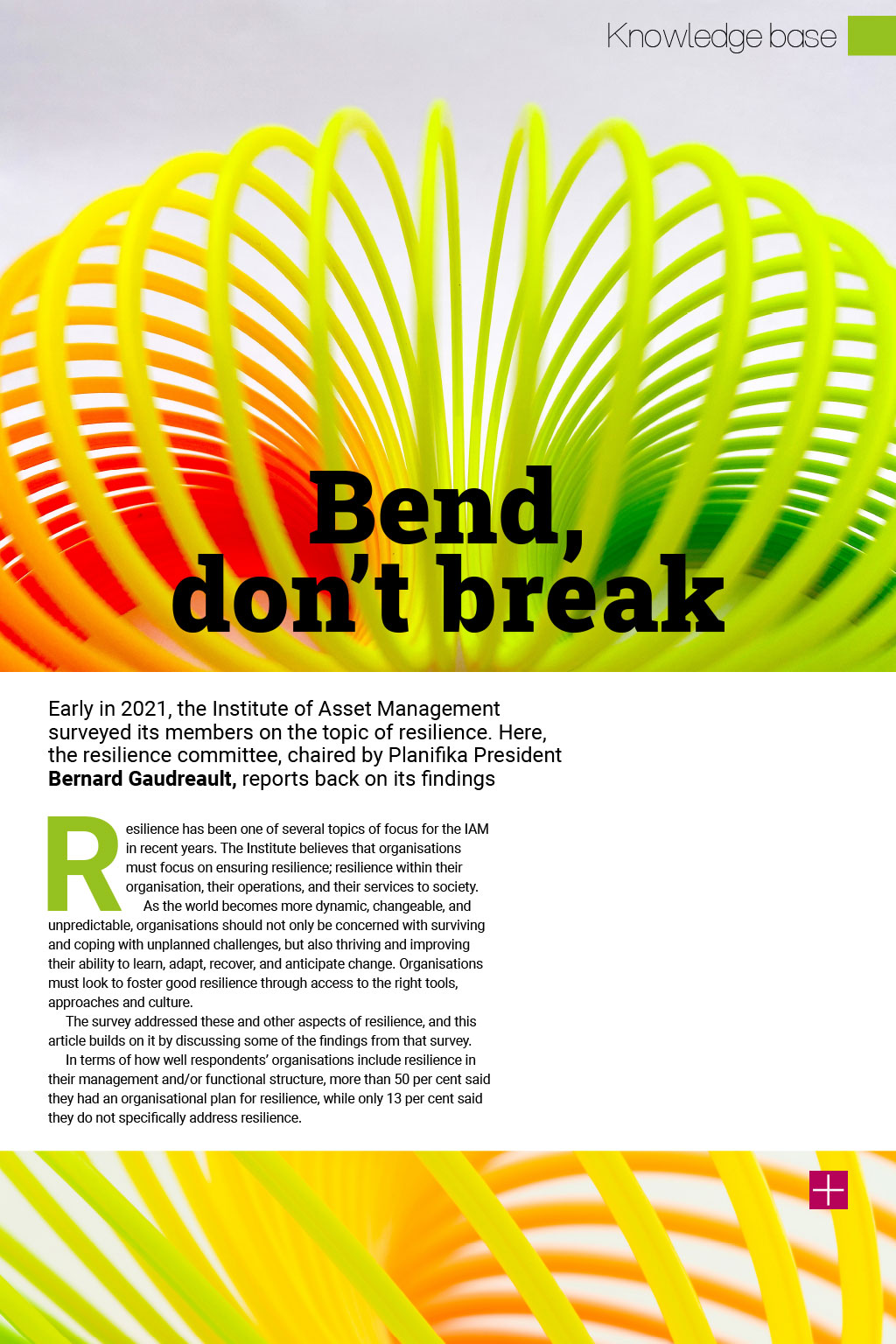

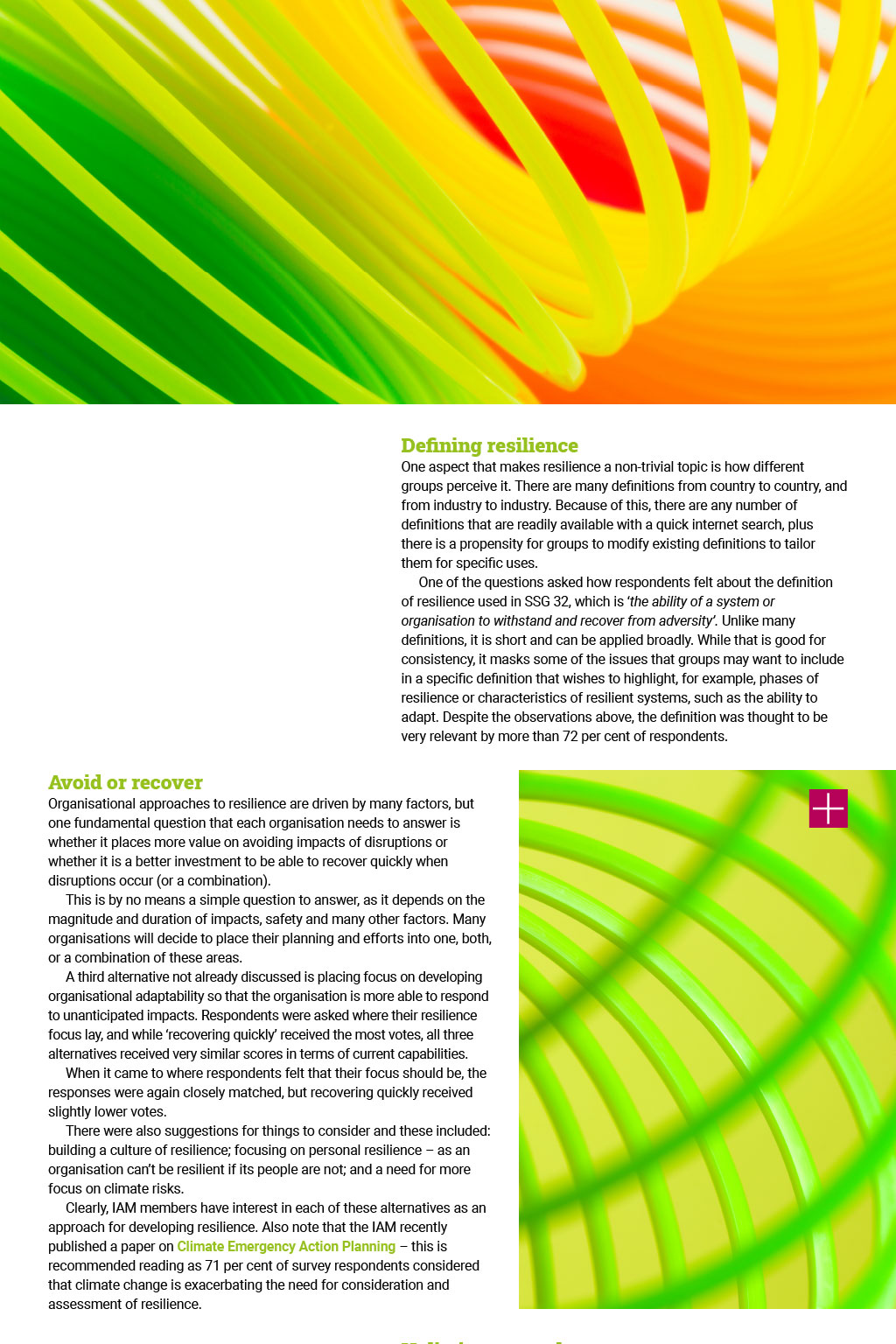
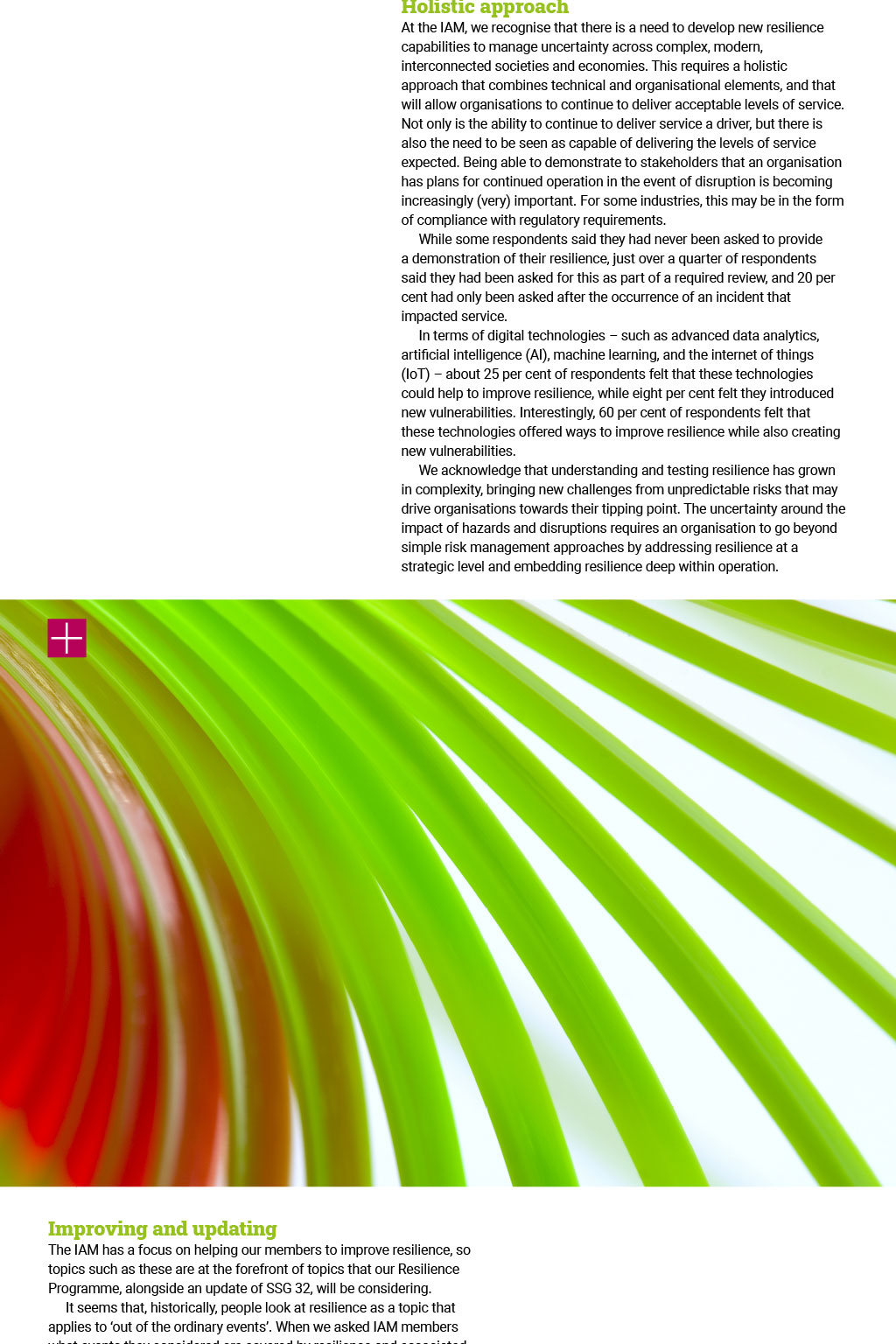
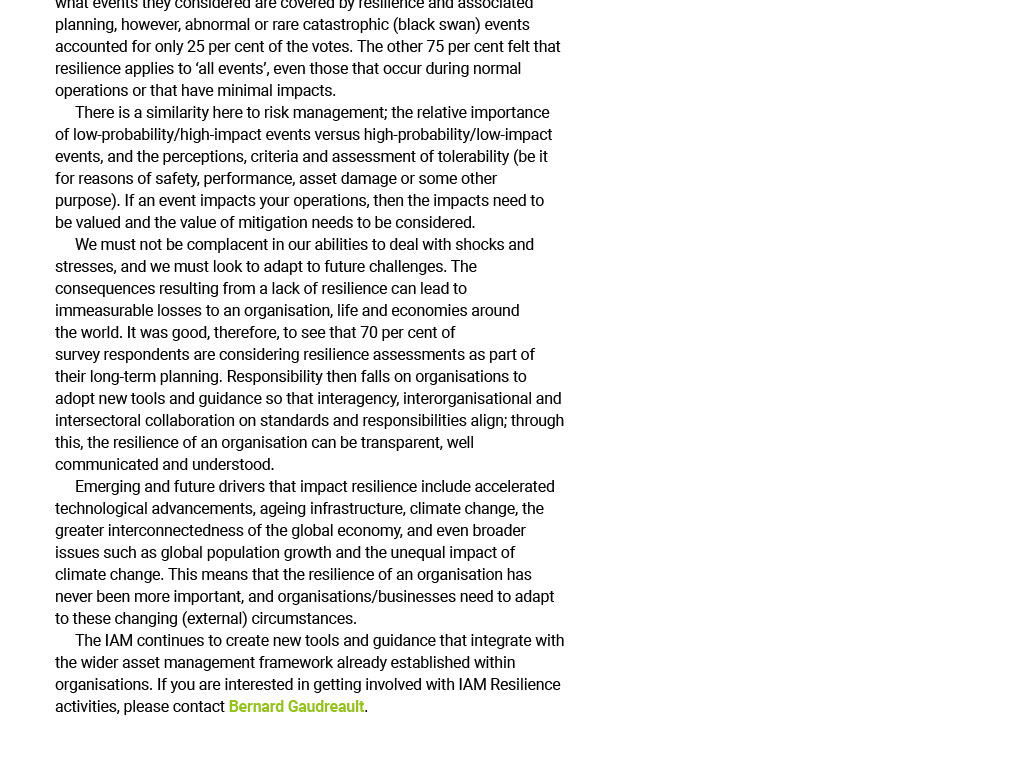





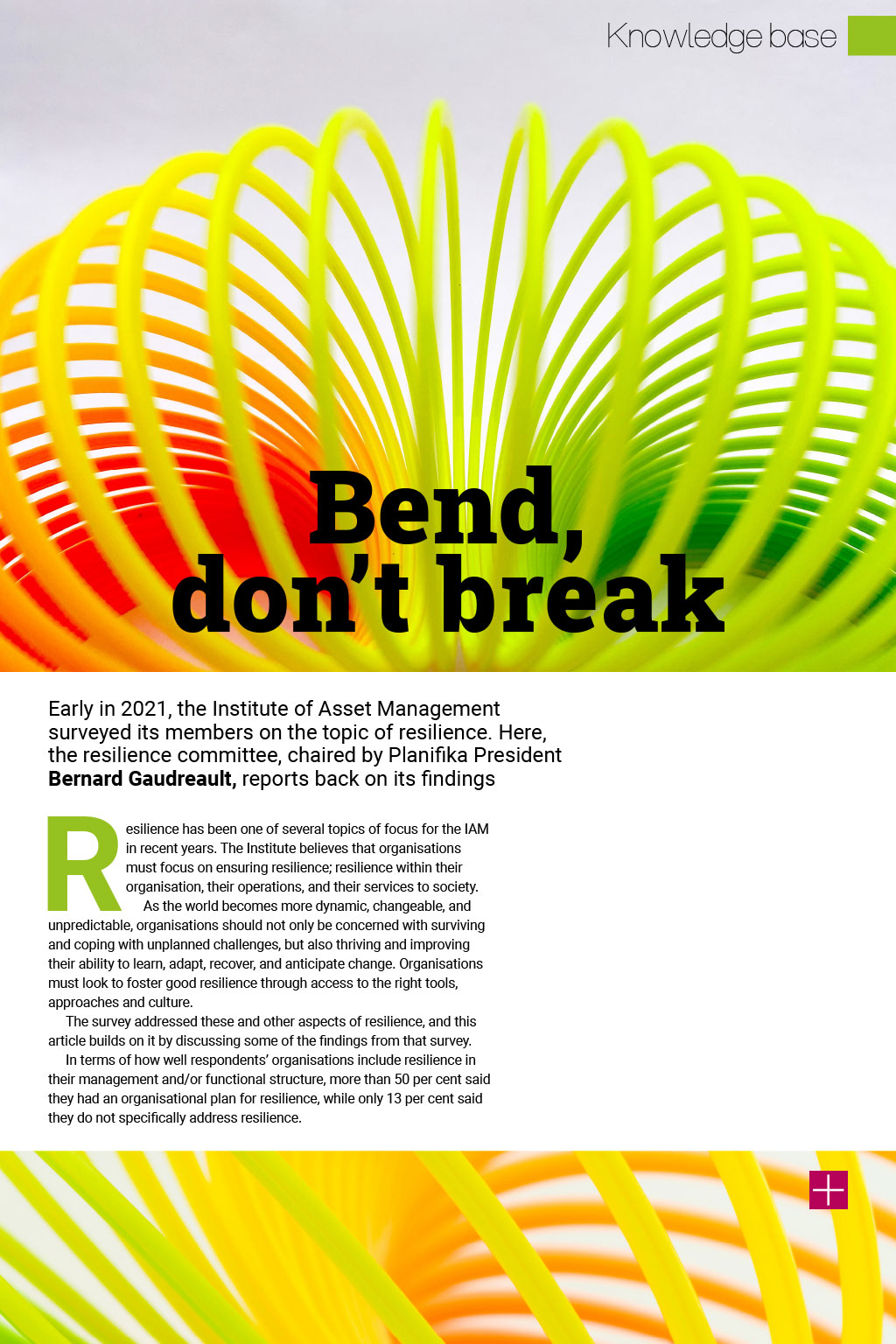
Early in 2021, the Institute of Asset Management surveyed its members on the topic of resilience. Here, the resilience committee, chaired by Planifika President Bernard Gaudreault, reports back on its findings Resilience has been one of several topics of focus for the IAM in recent years. The Institute believes that organisations must focus on ensuring resilience; resilience within their organisation, their operations, and their services to society. As the world becomes more dynamic, changeable, and unpredictable, organisations should not only be concerned with surviving and coping with unplanned challenges, but also thriving and improving their ability to learn, adapt, recover, and anticipate change. Organisations must look to foster good resilience through access to the right tools, approaches and culture. The survey addressed these and other aspects of resilience, and this article builds on it by discussing some of the findings from that survey. In terms of how well respondents organisations include resilience in their management and/or functional structure, more than 50 per cent said they had an organisational plan for resilience, while only 13 per cent said they do not specifically address resilience. more than 71% of survey 50% said that they had an respondents considered that climate change is exacerbating the need for consideration and assessment of resilience organisational plan for resilience 13% said that they do not specifically address resilience Defining resilience One aspect that makes resilience a non-trivial topic is how different groups perceive it. There are many definitions from country to country, and from industry to industry. Because of this, there are any number of definitions that are readily available with a quick internet search, plus there is a propensity for groups to modify existing definitions to tailor them for specific uses. One of the questions asked how respondents felt about the definition of resilience used in SSG 32, which is the ability of a system or organisation to withstand and recover from adversity. Unlike many definitions, it is short and can be applied broadly. While that is good for consistency, it masks some of the issues that groups may want to include in a specific definition that wishes to highlight, for example, phases of resilience or characteristics of resilient systems, such as the ability to adapt. Despite the observations above, the definition was thought to be very relevant by more than 72 per cent of respondents. Avoid or recover Organisational approaches to resilience are driven by many factors, but one fundamental question that each organisation needs to answer is whether it places more value on avoiding impacts of disruptions or whether it is a better investment to be able to recover quickly when disruptions occur (or a combination). This is by no means a simple question to answer, as it depends on the magnitude and duration of impacts, safety and many other factors. Many organisations will decide to place their planning and efforts into one, both, or a combination of these areas. A third alternative not already discussed is placing focus on developing organisational adaptability so that the organisation is more able to respond to unanticipated impacts. Respondents were asked where their resilience focus lay, and while recovering quickly received the most votes, all three alternatives received very similar scores in terms of current capabilities. When it came to where respondents felt that their focus should be, the responses were again closely matched, but recovering quickly received slightly lower votes. There were also suggestions for things to consider and these included: building a culture of resilience; focusing on personal resilience as an organisation cant be resilient if its people are not; and a need for more focus on climate risks. Clearly, IAM members have interest in each of these alternatives as an approach for developing resilience. Also note that the IAM recently published a paper on Climate Emergency Action Planning this is recommended reading as 71 per cent of survey respondents considered that climate change is exacerbating the need for consideration and assessment of resilience. The definition used in SSG 32 thought to be very relevant by more than 72% of respondents Holistic approach At the IAM, we recognise that there is a need to develop new resilience capabilities to manage uncertainty across complex, modern, interconnected societies and economies. This requires a holistic approach that combines technical and organisational elements, and that will allow organisations to continue to deliver acceptable levels of service. Not only is the ability to continue to deliver service a driver, but there is also the need to be seen as capable of delivering the levels of service expected. Being able to demonstrate to stakeholders that an organisation has plans for continued operation in the event of disruption is becoming increasingly (very) important. For some industries, this may be in the form of compliance with regulatory requirements. While some respondents said they had never been asked to provide a demonstration of their resilience, just over a quarter of respondents said they had been asked for this as part of a required review, and 20 per cent had only been asked after the occurrence of an incident that impacted service. In terms of digital technologies such as advanced data analytics, artificial intelligence (AI), machine learning, and the internet of things (IoT) about 25 per cent of respondents felt that these technologies could help to improve resilience, while eight per cent felt they introduced new vulnerabilities. Interestingly, 60 per cent of respondents felt that these technologies offered ways to improve resilience while also creating new vulnerabilities. We acknowledge that understanding and testing resilience has grown in complexity, bringing new challenges from unpredictable risks that may drive organisations towards their tipping point. The uncertainty around the impact of hazards and disruptions requires an organisation to go beyond simple risk management approaches by addressing resilience at a strategic level and embedding resilience deep within operation. 60% of respondents felt that technologies offered ways to improve resilience while also creating new vulnerabilities 8% felt that they introduced new vulnerabilities Improving and updating The IAM has a focus on helping our members to improve resilience, so topics such as these are at the forefront of topics that our Resilience Programme, alongside an update of SSG 32, will be considering. It seems that, historically, people look at resilience as a topic that applies to out of the ordinary events. When we asked IAM members what events they considered are covered by resilience and associated planning, however, abnormal or rare catastrophic (black swan) events accounted for only 25 per cent of the votes. The other 75 per cent felt that resilience applies to all events, even those that occur during normal operations or that have minimal impacts. There is a similarity here to risk management; the relative importance of low-probability/high-impact events versus high-probability/low-impact events, and the perceptions, criteria and assessment of tolerability (be it for reasons of safety, performance, asset damage or some other purpose). If an event impacts your operations, then the impacts need to be valued and the value of mitigation needs to be considered. We must not be complacent in our abilities to deal with shocks and stresses, and we must look to adapt to future challenges. The consequences resulting from a lack of resilience can lead to immeasurable losses to an organisation, life and economies around the world. It was good, therefore, to see that 70 per cent of survey respondents are considering resilience assessments as part of their long-term planning. Responsibility then falls on organisations to adopt new tools and guidance so that interagency, interorganisational and intersectoral collaboration on standards and responsibilities align; through this, the resilience of an organisation can be transparent, well communicated and understood. Emerging and future drivers that impact resilience include accelerated technological advancements, ageing infrastructure, climate change, the greater interconnectedness of the global economy, and even broader issues such as global population growth and the unequal impact of climate change. This means that the resilience of an organisation has never been more important, and organisations/businesses need to adapt to these changing (external) circumstances. The IAM continues to create new tools and guidance that integrate with the wider asset management framework already established within organisations. If you are interested in getting involved with IAM Resilience activities, please contact Bernard Gaudreault. 75% felt that resilience applies to all events 70% of survey respondents are considering resilience assessments as part of their longterm planning